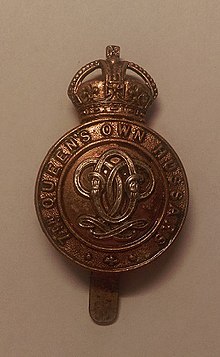7th Queen's Own Hussars
| 7th Queen's Own Hussars | |
|---|---|

Crest and tie colours of the 7th Hussars
|
|
| Active | 1689–1714 1715–1958 |
| Country |
|
| Branch | Army |
| Type | Cavalry of the Line/Royal Armoured Corps |
| Role | Light Cavalry |
| Size | one regiment |
| Nickname(s) | The Saucy Seventh/The Lilywhite Seventh |
| Motto(s) | Honi soit qui mal y pense (French, Evil Upon Him who Evil Thinks) |
| March | (Canter) The Campbells Are Coming (Quick) Bannocks o'Barley Meal (Slow) The Garb of Old Gaul |
| Anniversaries | Waterloo Day |
| Commanders | |
| Notable commanders |
Field Marshal Earl Haig |
The 7th Queen's Own Hussars was a cavalry regiment in the British Army, first formed in 1690. It saw service for three centuries, including the First World War and the Second World War. The regiment survived the immediate post-war reduction in forces, but was slated for reduction in the 1957 Defence White Paper, and was amalgamated with the 3rd The King's Own Hussars, to form the Queen's Own Hussars in 1958.
The regiment was first raised by Brigadier-General Richard Cunningham as The Queen's Own Regiment of Dragoons in May 1689, by the regimenting of various independent troops, and was ranked as the 7th Dragoons and named for Queen Mary. The regiment fought at the Siege of Namur in July 1695. The Hon William Kerr became colonel in 1709 in the closing stages of the Nine Years' War. The regiment was disbanded in 1714, with its squadrons joining the 1st and 2nd Dragoons, but reformed in 1715 as The Princess of Wales's Own Regiment of Dragoons, named for Princess Caroline.
The regiment marched up to Scotland in October 1715 and fought the rebels at the Battle of Sheriffmuir in November 1715 during the Jacobite rising. The regiment was retitled on Caroline's coronation as Queen Consort, becoming The Queen's Own Regiment of Dragoons in 1727. The regiment next saw action when it took part in charges at the Battle of Dettingen in June 1743 and at the Battle of Fontenoy in May 1745 during the War of the Austrian Succession. It saw action again at the Battle of Rocoux in October 1746 and the Battle of Lauffeld in July 1747. The regiment was formally titled as the 7th (The Queen's Own) Regiment of Dragoons in 1751.
...
Wikipedia
